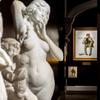Liberation and the Modern Era: Women in Modern Art
- April 15, 2015 13:33
This is the third of a three part series of blog posts preceding our exhibition Innocence, Temptation and Power: The Evolution of Women in Art, on view at M.S. Rau Antiques now through May 4.
A time of tumult both socially and politically, the early 20th century is remembered as an era of upheaval in the Western world. Two world wars, economic hardships and social revolutions affected the course of social history, and the art of the period came to reflect the rapidly evolving landscape of a new modern era.
The power of the person truly culminated in the art of the period, and with each passing decade, depictions of women came to reflect the emergence of a new liberated woman. Through both an artistic empowerment of women and the then energized Feminist Movement, women became less objects for a viewer’s pleasure and instead independent characters. A remarkable oil on canvas by American Impressionist Martha Walter entitled Employment Station is a powerful and progressive work of social realism that is an evocative illustration of the new image of women in society. Walter’s vivid color palette imbues her female subject with a wonderful sense of strength and hope, as she presumably awaits her fate in her attempt to join the workforce. The dawn of the 20th century set into motion a colossal social shift, propelling women into the workforce and other traditionally male spheres. Here, Walter depicts her female subject as she faces these changes with strength and pride.
Even the most traditional of artists contributed to the new complexity of womanhood, proving that women had the power to determine their own place in the world, however radical or conservative. Norman Rockwell’s Excuse Me can be viewed as both a humorous narrative and an early indication of the emerging modern woman of the 1920s. Depicting a fashionably dressed woman choosing a WWI soldier over a man of wealth, the work indicates a power of choice that was unavailable to the young woman just a generation before. Rockwell’s woman stands at the crest of an age of rapidly expanding women’s rights and roles, just on the verge of women’s suffrage in the United States.
As artists explore new ways of seeing, we see the visual narrative moving further and further away from the academic ideal we see in artists such as John William Godward and Guillaume Seignac. More than any other artist, Picasso defined Modern Art of the twentieth century by his establishment and development of one of its major movements, Cubism. His work Jacqueline au chapeau noir, depicting the young Jacqueline Roque, is a stunning example. Picasso exhibits a warmth toward his model (who was his second wife), and even as he puts her face through his exercises in distortion, she never appears monstrous. Picasso presents here a new way of looking – the human form is deidealized and considered in a new way that forces the viewer experience her more dynamically. With his Cubist works, Picasso paved the way for the pure abstraction that would dominate Western art for the next 50 years, a genre which arguably shifted the art historical narrative into a conceptual, gender-free space.
To learn more about the story of women in art, please join us for Innocence, Temptation and Power: The Evolution of Women in Art, on view at M.S. Rau Antiques now through May 4.
About M.S. Rau Antiques:
M.S. Rau Antiques has spent over 100 years earning the trust of discerning collectors world-wide. Located in the heart of New Orleans’ historic French Quarter, our peerless gallery showcases some of the world’s most extensive and stunning works of important fine art by artists such as Monet and van Gogh, rare 18th-and 19th-century antiques and breathtaking jewelry, including rare colored diamonds.






100x100_n.jpg)
100x100_c.jpg)












100x100_c.jpg)
